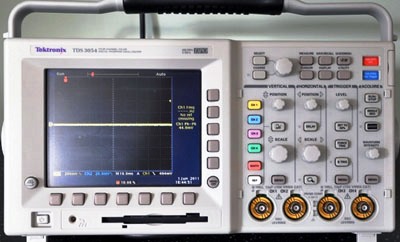
|
|
100 MHz Digital Storage Oscilloscope, Four Channel. Sample Rate on Each Channel: 1.25 GS/s. Maximum Record Length: 10K points. Vertical Resolution: 9–bits. Vertical Sensitivity (/div): 1 mV-10 V. Vertical Accuracy: ±2%. Max Input Voltage (1 megohm): 150V RMS CAT I. Position Range: ±5 div. Bandwidth Limit: 20 MHz. Input Coupling: AC, DC, GND. Input Impedance Selections: 1 megaohm in parallel with 13 pF, or 50 ohm. Time Base Range: 4 ns - 10 s/div. Accuracy: 200 ppm. Acquisition Modes; DPO - Captures and displays complex waveforms, random events, and subtle patterns in actual signal behavior. DPOs are able to provide 3 dimensions of signal information, in real-time; amplitude, time, and the distribution of amplitude over time. Peak Detect - High frequency and random glitch capture. Captures glitches as narrow as 1 ns. Sample - Sample data only. Envelope - Max/Min values acquired over one or more acquisitions. Average - Waveform data from 2 to 572 (selectable) acquisitions is averaged. Single Sequence - Use SINGLE SEQUENCE button to capture a single triggered acquisition sequence at a time. Main Trigger Modes: Auto (supports Roll Mode for 40 ms/div and slower), Normal. B Trigger: Trigger after time or events. Trigger After Time Range: 13.2 ns to 50 s. Trigger Types; Edge: Conventional level-driven trigger. Positive or negative slope on any channel. Coupling selections: DC, noise reject, HF reject, LF reject. Video: Trigger on all lines or individual line, odd/even or all fields, or analog HDTV formats (1080i, 1080p, 720p, 480p). WIDTH (or GLITCH): Trigger on pulse width less than, greater than, equal to, or not equal to a selectable time limit ranging from 39.6 ns to 50s. RUNT: Trigger on a pulse that crosses one threshold but fails to cross a second threshold before crossing the first again. SLEW RATE: Trigger on pulse edge rates that are either faster or slower than a set rate. Edges can be rising, falling, or either. Full VGA Color LCD
|